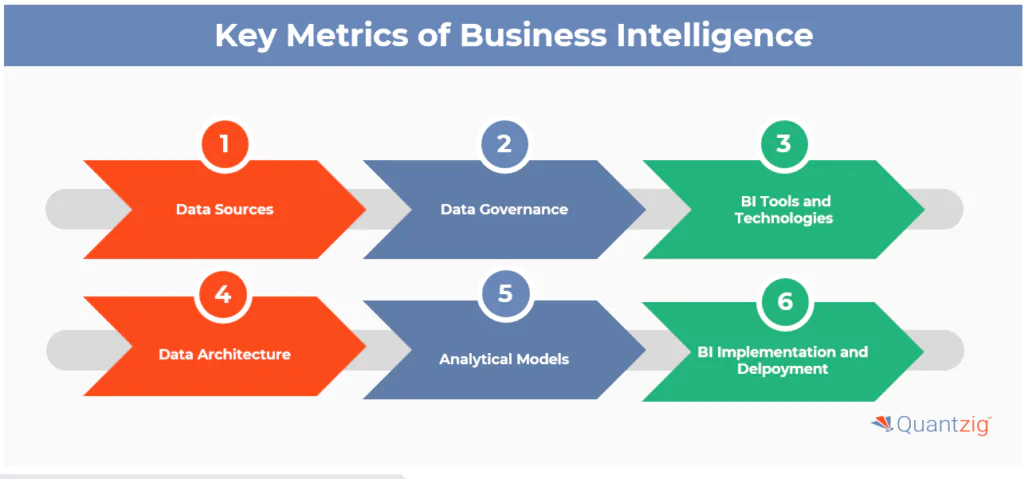A business intelligence strategy encompasses the steps needed to integrate a BI system within your company. This involves identifying key stakeholders, evaluating the current situation, setting objectives, and determining the key performance indicators (KPIs) that will gauge progress. The strategy is developed around vision, organizational structure, workflows, architecture, and solutions. Subsequently, a roadmap is devised based on the evaluation, prioritization, and feasibility. Executing a business intelligence implementation is a complex endeavor, requiring thorough groundwork, stakeholder coordination, and financial investment.
However, the benefits far outweigh the costs. While quantifying the return on investment (ROI) might be challenging, it’s widely acknowledged. Neglecting this implementation can lead to more significant setbacks in the long term. This article explores the process of crafting a robust business intelligence strategy, its multifaceted components, and the importance of a well-structured BI roadmap.
Book a demo to experience the meaningful insights we derive from data through our analytical tools and platform capabilities. Schedule a demo today!
Request a Free DemoTable of Contents
What Is a Roadmap Business Intelligence Strategy?
To describe business intelligence (BI) strategy, it is a plan that outlines how an organization will use data analytics and BI tools to gather, analyze, and leverage data to make informed business decisions. BI strategies that aligns with the organization’s overall business goals and objectives, and it can include processes, technologies, and methods for collecting, managing, and utilizes data effectively, it is well-defined. Here are the key components and aspects to keep in mind before implementing a BI strategy:

- Data Sources: Identifying and managing sources of data such as databases, data warehouses, cloud storage, and external data sources. Ensuring data quality and integrity is crucial.
- Data Governance: Establishing policies and procedures for managing data, including data security, privacy, and compliance with relevant regulations.
- BI Tools and Technologies: Selecting the appropriate BI tools and technologies for data analysis and reporting. This includes data visualization tools, reporting software, and advanced analytics tools.
- Data Architecture: Designing an efficient data architecture that supports data integration, storage, and retrieval. This may include setting up data warehouses, data lakes, or data marts.
- Analytical Models: Developing analytical models and methods for transforming raw data into actionable insights. This may involve statistical analysis, machine learning, or artificial intelligence techniques.
- BI Implementation and Deployment: Business intelligence planning and executing the deployment of BI solutions across the organization. This includes user training, technical support, and ongoing maintenance.
A successful business intelligence roadmap template can help an organization gain a competitive advantage by providing insights that enable better decision-making, improved operational efficiency, and greater Customer engagement and customer satisfaction.
How Quantzig Helps with Business Intelligence Strategies
Quantzig’s approach to developing robust Business Intelligence (BI) strategy for enterprises is both systematic and comprehensive, ensuring that each step aligns with your business goals and operational needs.
- Identifying Data Sources: We assess all data sources, including internal and external repositories, and evaluate your existing BI tools to ensure they meet your strategic needs.
- Defining BI Goals: Quantzig collaborates with you to set measurable BI goals that align with your business objectives, driving focused initiatives linked to key performance indicators key performance indicators (KPIs).
- Engaging Key Stakeholders: We involve all relevant stakeholders, customizing BI tools and reports to meet the diverse needs of executives and employees alike.
- Developing a BI Strategy: We create a clear roadmap, detailing tasks, timelines, and budgets to ensure efficient strategy execution and resource management.
- Selecting the Right BI Tools: Quantzig helps you choose the most suitable BI tools, prioritizing those that integrate seamlessly with your systems and offer scalability.
- Establishing Data Governance: We implement data governance policies to ensure data accuracy, security, and accessibility, building trust in your BI outputs.
- Designing a Scalable Architecture: Quantzig designs BI infrastructure that can scale with your organization’s growth, accommodating increased data and user demands.
- Implementing the BI Strategy: Our team sets up data warehouses, integrates diverse data sources, and develops reports and dashboards for actionable insights.
- Training Users: We provide comprehensive training to empower your team to effectively use BI tools and interpret data for strategic decision-making.
- Measuring Results: Quantzig continuously evaluates your BI strategy’s effectiveness, refining it to ensure it delivers impactful, actionable insights.
Experience the advantages firsthand by testing a customized complimentary pilot designed to address your specific requirements. Pilot studies are non-committal in nature.
Request a free pilotBenefits of a enterprise business intelligence strategy
A business intelligence (BI) strategy offers numerous benefits to an organization, enabling it to leverage data effectively to improve decision-making, streamline operations, and achieve strategic objectives. Here are some of the key benefits of implementing a BI strategy:
- Better Decision-Making: A BI strategy provides accurate, timely, and relevant data and insights, helping decision-makers make informed choices that align with business outcomes and objectives.
- Improved Operational Efficiency: By analyzing data related to business processes, organizations can identify inefficiencies and areas for improvement, leading to streamlined operations and cost savings.
- Enhanced Customer Insights: BI tools can help organizations better understand Customer engagement behavior and preferences, enabling them to tailor products and services to meet Customer relationship management needs more effectively.
- Increased Competitive Advantage: Access to data-driven insights allows organizations to stay ahead of market trends and anticipate shifts in the industry, giving them an edge over competitors.
- Faster and More Accurate Reporting: BI tools enable automated data collection, analysis, and reporting, which speeds up the process and reduces the potential for human error.
- Improved Collaboration and Communication: A BI strategy promotes data sharing and collaboration across departments, allowing different teams to work together more effectively and make coordinated decisions.
- Identification of New Opportunities: By analyzing data from various sources, organizations can spot emerging trends and new business opportunities for better Return on investment that might otherwise go unnoticed.
- Better Resource Allocation: BI tools can provide insights into how resources are being utilized, allowing for more strategic allocation and management of resources.
- Risk Management: A BI strategy helps organizations monitor performance and market trends, which can aid in identifying potential risks and developing strategies to mitigate them.
- Increased Productivity: Automating data analysis and reporting processes frees up employees’ time, allowing them to focus on higher-value tasks and strategic initiatives.
- Enhanced Financial Management: BI tools provide a clearer picture of financial data, enabling better budgeting, forecasting, and financial planning.
- Regulatory Compliance: By maintaining accurate and accessible data, BI strategies help organizations stay compliant with regulatory requirements and standards.
Overall, a robust BI strategy empowers organizations to harness the full potential of their data, driving innovation and supporting sustainable growth.
Challenges present in implementing a Business Intelligence Strategy for Enterprises:

Lack of buy-in from senior management:
Business Intelligence (BI) constitutes a strategic investment with substantial implications. Garnering endorsement from senior management is pivotal for ensuring its triumph. Senior management buy-in affirms the strategic relevance of BI, validating its potential to drive informed decisions and bolster organizational growth. This backing secures essential assets, from financial allocations to necessary manpower, enabling the development of a robust BI infrastructure. Aligning BI objectives with the overarching business goals becomes tangible when senior management champions the initiative.
Unclear goals and objectives:
Clarity in aspirations is the lodestar that guides the BI journey. Defining what you intend to accomplish through BI lays the foundation for strategic alignment and purpose-driven actions. With well-defined objectives, the BI roadmap gains direction and purpose, mapping out the sequence of steps to manifest your goals. By anchoring your roadmap in tangible goals, you not only chart a path for BI implementation but also forge a potent link between data insights and organizational success.
Lack of data:
The efficacy of Business Intelligence (BI) hinges on the quality and relevance of the data at hand. In the absence of pertinent data, deriving the requisite insights becomes an insurmountable challenge. Pioneering a successful BI roadmap mandates a robust comprehension of your data landscape. This entails assessing the data sources, their accuracy, completeness, and compatibility with your objectives. Preceding BI roadmap development, a meticulous grasp of your data ecosystem is non-negotiable. Aligning your BI roadmap with a holistic comprehension of your data repertoire ensures that the resultant insights are accurate, reliable, and instrumental in driving organizational success.
Lack of skills and resources:
The creation and execution of a Business Intelligence (BI) roadmap demands a spectrum of essential skills and resources. A proficient team possessing the requisite expertise is pivotal for constructing and maintaining the BI solution. Skill sets encompass data analysis, visualization, data engineering, and software management. Adequate funding for BI tools, robust servers, and scalable databases ensures the technological backbone of the roadmap. Inadequacies in skills or resources can impede the BI roadmap, highlighting the need for comprehensive alignment between human capital and technological provisions to drive the success of BI endeavors.
Changing requirements:
The dynamic nature of the business landscape renders the requirements for Business Intelligence tools perpetually fluid. Navigating this ever-changing terrain mandates a culture of adaptability and flexibility within BI roadmaps. This necessitates regular reassessment and refinement to ensure that BI goals remain congruent with current imperatives. An adaptive BI roadmap stands as a strategic asset, poised to harness the tide of change to deliver insights that drive informed actions, thereby sustaining the relevance and efficacy of the BI initiative.
Lack of user adoption:
A stellar Business Intelligence (BI) solution’s efficacy hinges on user adoption. Irrespective of its prowess, if users do not embrace it, success remains elusive. User training and support amplify proficiency, enhancing the solution’s appeal. A user-adopted BI solution generates a ripple effect, fueling data-driven insights, informed actions, and organizational growth. The crux lies in crafting an intuitive and compelling BI experience that catalyzes engagement, transforming data into an ally that propels the achievement of strategic objectives.
Get started with your complimentary trial today and delve into our platform without any obligations. Explore our wide range of customized, consumption driven analytical solutions services built across the analytical maturity levels.
Start your free trialEnding Thoughts
Crafting a comprehensive business intelligence strategy is the compass that directs enterprises toward harnessing data’s transformative power. Through stakeholder alignment, precise goal delineation, strategic KPI identification, and visionary mapping, the foundation is laid. Organizational structuring, process refinement, architectural design, and solution selection follow, forging a robust framework. Ultimately, the orchestration of a BI strategy culminates in an informed, agile, and growth-oriented organization, where data is harnessed as a potent asset for decisive excellence. The BI roadmap is more than a technical trajectory; it’s a transformative odyssey that elevates enterprises into the realm of data-driven success.




